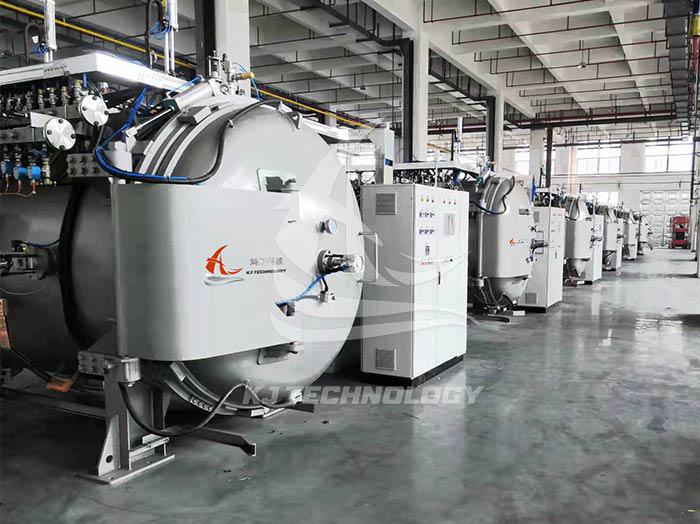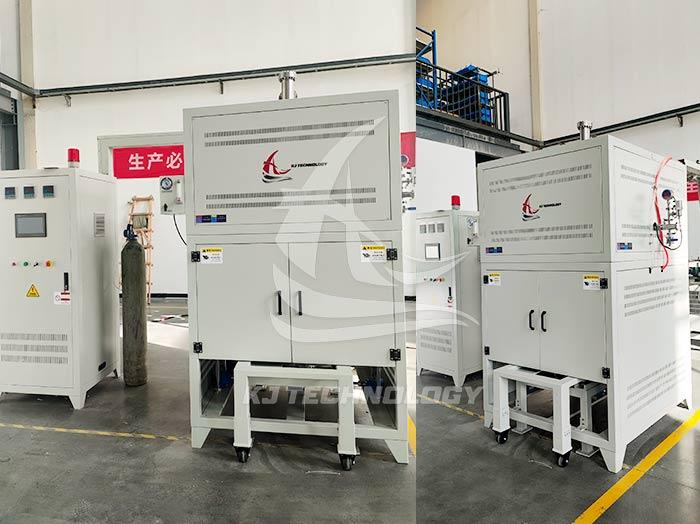Application of Vacuum Hot Pressing Furnace in Ceramic Industry
 07-07-2025 Author: KJ technology
07-07-2025 Author: KJ technology
In the ceramic industry, the vacuum hot press furnace achieves the preparation of highly dense and high-performance ceramic materials through the synergistic effect of vacuum environment, high-temperature heating, and mechanical pressure. Its core applications and advantages are as follows:
1. Core application areas
Densification and sintering of high covalent bonding ceramics
Typical materials: boron carbide (B ₄ C), silicon carbide (SiC), silicon nitride (Si ∝ N ₄), etc.
Technical challenges: These materials have strong covalent bonds (such as B ₄ C covalent bonds accounting for 93.94%), low diffusion coefficients, and require atmospheric sintering at temperatures above 2200 ℃ with insufficient density (only 80% -87%).
Vacuum hot pressing solution:
After hot pressing sintering at 2150 ℃ for 10 minutes, the relative density of B ₄ C ceramics can reach 91.6%, with a room temperature Young's modulus of 292.5 GPa and a Poisson's ratio of 0.16;
By using the liquid-phase sintering mechanism, sintering aids (such as Al ₂ O ∝ - Y ₂ O ∝) are added to SiC sintering to promote densification and suppress abnormal grain growth.
Preparation of Transparent Ceramics
Technical principle: Vacuum environment reduces gas impurities, avoids residual pores, and improves transparency.
Typical case:
YAG: Nd transparent ceramics achieved a relative density of 99.98% and an average grain size of 50 μ m through vacuum sintering, achieving laser output for the first time;
Alumina ceramics obtained a grain size of 0.5 μ m and a bending strength of 500 MPa under hot pressing at 1450 ℃.
Synthesis of Fine grained Ceramics
Technical advantages: Pressure suppresses grain growth, and vacuum environment accelerates pore discharge.
Typical case:
Aluminum nitride (AlN) ceramics have a lower lattice oxygen content under hot pressing sintering compared to atmospheric pressure sintering, and a thermal conductivity of 200 W/m · K;
Silicon nitride (Si ∝ N ₄) ceramics were sintered by hot pressing to obtain a thermal conductivity of 129 W/m · K and a bending strength of 1149 MPa.
2. Analysis of Technical Advantages
Reduce sintering temperature and shorten time
The hot pressing sintering temperature is 200-400 ℃ lower than atmospheric pressure. For example, the B ₄ C sintering temperature is reduced from 2250-2300 ℃ to 2150 ℃, and the sintering time is shortened from several hours to 10 minutes.
Mechanism: Pressure promotes particle rearrangement and plastic flow, accelerating mass transfer processes.
Inhibit grain coarsening and improve material properties
Vacuum environment reduces oxidation, pressure restricts grain boundary movement, and obtains fine grain structure (grain size ≤ 1 μ m).
Effect: Material hardness (HRA ≥ 92), flexural strength (≥ 1000 MPa), and fracture toughness (≥ 5.7 MPa · m ¹/²) are significantly improved.
Realize complex shape forming
Ceramic materials exhibit thermoplasticity at high temperatures and can be used to produce shaped products such as thin-walled tubes and spherical columns, breaking through the shape limitations of traditional cold pressing processes.
Support the manufacturing of large-sized products
The unit pressing pressure of hot pressing is only one tenth of that of cold pressing, and the product size can be enlarged by welding. Currently, ceramic products produced by hot pressing can weigh tens to hundreds of kilograms.
3. Industry application cases
aerospace field
Application scenarios: High temperature resistant components such as turbine blades and combustion chamber liners.
Process effect: Hot pressed sintered Si ∝ N ₄ ceramics are formed at 1600-1800 ℃ and 50-100 MPa pressure, with significantly improved high-temperature strength (≥ 1000 MPa) and creep resistance.
Electronic industry
Application scenarios: High power LED heat dissipation substrate, microwave device packaging.
Process effect: The thermal conductivity of AlN ceramics sintered by hot pressing reaches 200 W/m · K, meeting the high-efficiency heat dissipation requirements of electronic devices.
Optical field
Application scenarios: Laser transparent ceramics, infrared window materials.
Process effect: YAG: Nd ceramics sintered by vacuum hot pressing have a light transmittance of ≥ 80% and stable laser output power.








